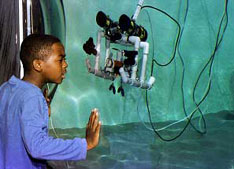
During Explorations! Focus on Underwater Archaeology, visitors learn how MIT's Deep Archaeology Lab uses sound to map shipwrecks by building and testing remote underwater vehicles that use sound to navigate.

Sea Floor Science adapts an operational ocean bottom seismometer from the Scripps Institution of Oceanography's Institute of Geophysics and Planetary Physics to allow visitors and students to conduct a series of increasingly more difficult experiments on energy transmission.

During Slopes, Slides and Tsunamis, Neal Driscoll from Scripps Institution of Oceanography's Geosciences Research Division delivers an 'interactive scientist presentation' designed to engage audiences of all ages.
|
Sea Floor Science
The Ocean Institute was fortunate to receive funding from the National Science Foundation for Sea Floor Science to examine the process of science translation in a new way. The three-year project began in 2003 looking at exhibit convertibility and adaptability. We wanted to know how an exhibit could be developed to meet both the relatively modest needs of the public and also the rather stringent needs of an 18-hour middle school overnight program. In addition, we were interested in how exhibits and programs might be designed to be more responsive to relevant scientific updates or developed quickly enough to represent current science. Sea Floor Science creates 4-month intensive explorations of current ocean science topics. The project defines a new process for efficiently recruiting scientists, translating complex science and employing informal science center tools. To date, Sear Floor Science has presented Surfscience, Explorations! A Focus on Underwater Archaeology, Slopes, Slides and Tsunamis and Lights! Cameras! interActions! and is in development of Exploring Life in the Extreme. Sea Floor Science has helped to push the current definition of exhibit by creating new types of learning spaces that deliver a broader spectrum of visitor experiences and can be more readily updated to reflect changing science. In Slopes, Slides and Tsunamis, science on the potential instability of continental shelves caused by methane hydrates conducted by Scripps Institution of Oceanography, Monterey Bay Aquarium Research Institution and United States Geological Survey was presented in an interesting combination of facilitated and non-facilitated exhibits, family kits, interactive scientist presentations, 60-minute activity tours, take-out science kits, self-guided science explorations and live videoconferences from a research vessel off the coast of Papua New Guinea. Formative evaluations showed that diverse audiences were able to understand key messages when all the informal science education tools worked in synchrony. The Ocean Institute has developed a new and effective methodology for connecting scientists with informal science education centers. The project began with three partners, Jet Propulsion Lab, Scripps Institution of Oceanography and Texas A&M's Institute of Nautical Archaeology and quickly grew to include over a dozen major research institutions. Sea Floor Science has been successful at developing a sophisticated and efficient tool for busy scientists trying to meet broader impact initiatives. The model has been successfully applied to three recent NSF-funded ocean science projects. In addition, Sea Floor Science has informed NSF-funded Centers for Ocean Sciences Education Excellence and the RIDGE 2000 (group of 200 thermal vent scientists) by demonstrating a working model for building effective collaborations between the education and research communities. For more information:
• Sea Floor Science publications and presentations
• CORE Sea Floor Science is a project of the Ocean Institute's Center for Cooperation in Research and Education (CORE). |
Produced in collaboration with Scripps Institution of Oceanography.
Website by Earthguide.
© 2003-2005 by the Ocean Institute and
the Regents of the University of California.
All rights reserved.
Last modified Thursday, February 24, 2005
